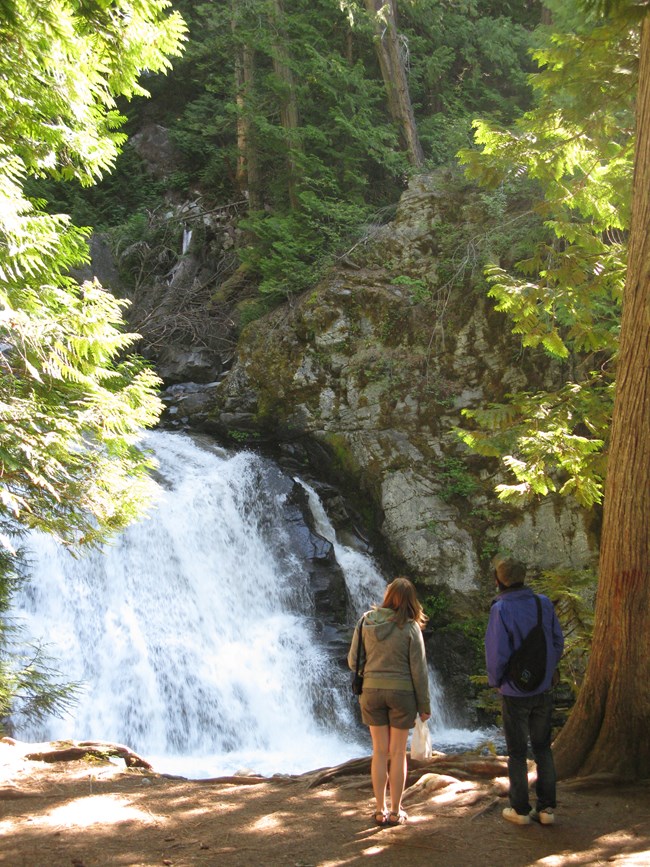
NPS photo
Dawn Chorus Not Just For Birds
World Listening Day, Monday, July 18, invites people to tune to the world of sound around them through the practice of listening. An annual event organized by the World Listening Project, this year's theme, "Sounds Lost and Found," presents opportunities for reflection on changes in one's soundscape that have occurred in recent decades.
Every national park has a unique soundscape, from the hissing geysers of Yellowstone to the echoing canyons of Zion and even the silent dunes of Great Sand Dunes. The National Park Service encourages individuals to get outside and get curious about the sounds unique to their area neighborhoods and parks.Far from being background chatter, the sounds tell a story, whether the chirps of newly hatched wrens in a backyard tree, the spine-tingling wail of a wolf on a ridge, or the thundering descent of a waterfall. With so much variety, there is plenty to hear and discover.
In his field notes, famed forester and ecologist Aldo Leopold (1887 –1948) details a chorus of joyful, natural sounds heard on the Sauk County, Wisconsin land he called home—of insects, birds, frogs, wolves, wind and rain.
He wrote, "Out of the clouds I hear a faint bark, as of a faraway dog. It is strange how the world cocks its ear to that sound, wondering. Soon it is louder: the honk of geese, invisible, but coming on."
Human-caused sounds are increasingly a part of people's outdoor listening experiences. Leopold witnessed the rise of the automobile, and the engine sounds that were new in the soundscape of his generation are commonly heard today, even in remote wilderness locations, whether the distant drone of an airplane, or a motorcycle winding its way through the landscape.
Leopold was an influential voice for preserving wild places when national parks were being created 100 years ago. He believed that tuning to nature is a vital step toward their protection, and that one must first perceive the music of a river before being moved to protect it:
"Our ability to perceive quality in nature begins, as in art, with the pretty. It expands through successive stages of the beautiful to values as yet uncaptured by language … the good life of any river may depend on the perception of its music;and the preservation of some music to perceive."
NPS works to protect natural soundscapes and hopes the more people hear, the more they will care. The following activities provide a spectrum of sound possibilities to explore alone or with family and friends on World Listening Day or any time throughout the year. What will you do to connect?
Wilderness listeningTake time for a silent sound-walk or sound-sit in a park or other location removed from distractions and rich with sounds. Consider the potential of different time frames—sounds heard in the morning will differ from those heard in the evening. Listen for a variety of sounds as you silently sit or move through the environment. If with friends and family, share your experiences. How many different sounds did you hear, and of what? Did anything you hear surprise you? Were any human-caused sounds heard? What else did you discover?
Group storytelling
Get with neighbors for a potluck and share stories about how sounds have changed in your community. Are there sounds you used to hear but no longer do? Perhaps the whinny of horses could be heard in a nearby field, but as the area developed, the field is now a parking lot, and the horses are gone. What new sounds have emerged in your neighborhood? The introduction of a new road to a community brings more traffic sounds;a protected area brings more bird songs. Do your neighbor's stories differ across age groups?
What's that sound?
Play field recordings of different natural sounds—frogs, foxes, woodpeckers, thunder, a rock slide, etc.—and have your kids or friends guess the source. Combine this activity with a discussion or hike that focuses on sounds in your community.
Music to your ears
Get out and hear a concert, or host one yourself featuring talented friends and neighbors.
Whirly gig
For interactive fun for kids, provide an assortment of tubes of varying lengths (purchased from a hardware store, for example), and let them experiment with twirling the tubes overhead. The hoses make interesting sounds that vary in pitch based on how fast the tubes spin. What else do you notice?
Scavenger hunt
Organize family members or friends into small teams to record sounds in your community using iPhones. Each team records a set number of sounds in an hour (100 seconds per sound for NPS's 100th birthday). The sounds could be found, or you could create a scavenger list (i.e., find a water source, bird, wind, human-caused sound, etc.). Arrange when and where to reconvene to hear each other's sounds and talk about the experiences.
A sound education
Facilitate a lecture or event that relates to acoustic ecology, field recordings, or a similar topic of your choosing.
Have fun creating your own sound exercises!
More ideas and ways to get involved:
- Power of Sound Interpretive Handbook
- Natural Sounds and Night Skies Division
- World Listening Project
- World Forum for Acoustic Ecology
- Deep Listening Institute, Ltd
Article by Julie West, communications specialist, National Park Service Natural Sounds and Night Skies Division
Last updated: October 30, 2018
